
CHAPTER TWENTY-NINE
Mode of operation
260
29.3.2
Hearing Level determination
The hearing threshold for these stimuli was determined in a group of 20
subjects with normal hearing aged <25. The stimuli were measured in
a Brϋel & Kjær Ear Simulator Type 4157. The differences between the
dBppSPL recorded in the B&K stimulator and the dBHL set on the Otoport
were noted:
Click dB Chirp dB
Otoport HL to ppeSPL conversion
34.2
29.8
29.3.3
Sensitivity
The sensitivity of a hearing screener relates to the ability of the device
to detect ears with hearing loss (the true positive rate). Sensitivity is
measured as the probability of a ‘No Valid ABR’ result being correctly
reported by the device when no ABR is actually present. Departure from
the desired 100% sensitivity figure indicates false passes caused by the
device misinterpreting electrical noise (biological and/or environmental) as
an ABR. The sensitivity of a device must therefore be measured with the
device operating in its screening test mode and exposed to all the differing
levels of EEG noise and power line interference in which the device can be
used, but without any ABR actually being present.
It is important to note that the measured sensitivity of an instrument relates
to the outcome of tests where there is no ABR present. When there is a
hearing loss we can assume that no ABR is present only if the stimulus
level is below the elevated threshold. The demonstrated instrument
sensitivity therefore only applies to the detection of hearing losses greater
than the hearing level of the applied stimulus. It is the applied stimulus
level that determines the range of hearing losses that will be detectable
and to which the sensitivity figure applies. For example if only a small
hearing loss is present such that the hearing threshold is still lower than the
hearing level of the applied stimulus, then a true ABR will be present. The
instrument may correctly detect that response and not detect the hearing
loss.
It is therefore strongly recommended that the stimulus level is set to the
lowest value compatible with the aims and targets of the hearing screening
programme. For the reliable detection of mild hearing impairment many
professionals bodies recommend stimulus levels 35dBnHL. Some major
infant screening programs use 40dBHL. Screening with stimulus levels
above 40dBnHL will miss some mild hearing losses.
Mode of operation
Summary of Contents for Otoport Advance
Page 296: ...CHAPTER THIRTY TWO Index 296...
















































